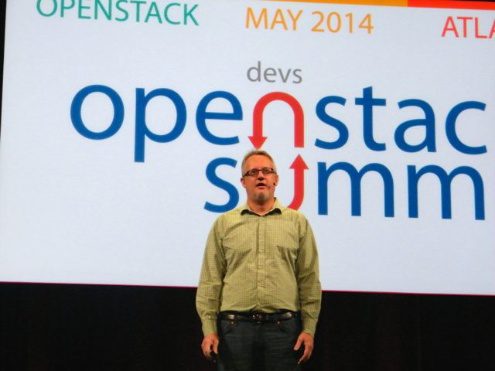Datamation content and product recommendations are
editorially independent. We may make money when you click on links
to our partners.
Learn More
ATLANTA. The open source OpenStack cloud platform is not a hobbyist project, it’s a technology platform that is powering major brands today. That’s the message coming loud and clear from the OpenStack Summit here in Atlanta.
During a keynote address, Mark Collier, Chief Operating Officer of the OpenStack Foundation, noted that since OpenStack was first created in 2010 there have been nine releases. The very first OpenStack release was codenamed Austin and the barrier to entry for submitting code to it wasn’t very high.
Cloud Storage and Backup Benefits
Protecting your company’s data is critical. Cloud storage with automated backup is scalable, flexible and provides peace of mind. Cobalt Iron’s enterprise-grade backup and recovery solution is known for its hands-free automation and reliability, at a lower cost. Cloud backup that just works.
SCHEDULE FREE CONSULT/DEMO
“What it took to be in the Austin release is you just had to be able to spell Austin,” Collier joked. “Four years and nine releases later, there are now 10 key components in the integrated release and it’s not just a bucket of parts.”
Collier noted that testing has really ramped up as well, with over 50 external testing system deployed for the recent Icehouse release. In contrast for the OpenStack Havana release in 2013, there were only two testing systems.
There is more interest in OpenStack now than ever before for a number of different reasons.
“It has a lot to do with the massive transformation going in the entire economy and there is a revolution going on and every company has to move faster,” Collier said. “Speed is the name of the game.”
AT&T is one of the companies that joined Collier on stage to discuss why OpenStack matters. Toby Ford, AVP for IT Operations Strategic Realization at AT&T, said that when he first started with the company, open source technology use was mostly forbidden. That’s no longer the case today.
“OpenStack is a proxy that has allowed us to get innovation into AT&T and it gives us an ecosystem that we can contribute into,” Ford said.
AT&T has been using OpenStack since 2010 and today has approximately 120 application running on the platform. Originally the OpenStack deployment was in three data centers but it has since expanded to seven data centers with plans to add three more by the end of the year.
For AT&T, OpenStack provides a platform for agility and it might also serve as a gateway to Network Function Virtualization (NFV). Ford said that OpenStack is well positioned to handle NFV workloads.
Joel Johnston, Platform Architect, Global Hosting, Sony Computer Entertainment America also joined Collier on stage to talk about his company’s experience with OpenStack. Sony uses OpenStack as its back-end platform that hosts software for connecting players online, provides stats, leaderboard and social media integration.
Collier commented that we’re now all living in a time when there is more disruption then ever before.
“Software is eating the world,” Collier said. “In today’s race faster wins – everything else is a rounding error.”

Mark Collier, Chief Operating Officer, OpenStack Foundation
Sean Michael Kerner is a senior editor at Datamation and InternetNews.com. Follow him on Twitter @TechJournalist
Photo courtesy of Shutterstock.
-
Huawei’s AI Update: Things Are Moving Faster Than We Think
FEATURE | By Rob Enderle,
December 04, 2020
-
Keeping Machine Learning Algorithms Honest in the ‘Ethics-First’ Era
ARTIFICIAL INTELLIGENCE | By Guest Author,
November 18, 2020
-
Key Trends in Chatbots and RPA
FEATURE | By Guest Author,
November 10, 2020
-
Top 10 AIOps Companies
FEATURE | By Samuel Greengard,
November 05, 2020
-
What is Text Analysis?
ARTIFICIAL INTELLIGENCE | By Guest Author,
November 02, 2020
-
How Intel’s Work With Autonomous Cars Could Redefine General Purpose AI
ARTIFICIAL INTELLIGENCE | By Rob Enderle,
October 29, 2020
-
Dell Technologies World: Weaving Together Human And Machine Interaction For AI And Robotics
ARTIFICIAL INTELLIGENCE | By Rob Enderle,
October 23, 2020
-
The Super Moderator, or How IBM Project Debater Could Save Social Media
FEATURE | By Rob Enderle,
October 16, 2020
-
Top 10 Chatbot Platforms
FEATURE | By Cynthia Harvey,
October 07, 2020
-
Finding a Career Path in AI
ARTIFICIAL INTELLIGENCE | By Guest Author,
October 05, 2020
-
CIOs Discuss the Promise of AI and Data Science
FEATURE | By Guest Author,
September 25, 2020
-
Microsoft Is Building An AI Product That Could Predict The Future
FEATURE | By Rob Enderle,
September 25, 2020
-
Top 10 Machine Learning Companies 2020
FEATURE | By Cynthia Harvey,
September 22, 2020
-
NVIDIA and ARM: Massively Changing The AI Landscape
ARTIFICIAL INTELLIGENCE | By Rob Enderle,
September 18, 2020
-
Continuous Intelligence: Expert Discussion [Video and Podcast]
ARTIFICIAL INTELLIGENCE | By James Maguire,
September 14, 2020
-
Artificial Intelligence: Governance and Ethics [Video]
ARTIFICIAL INTELLIGENCE | By James Maguire,
September 13, 2020
-
IBM Watson At The US Open: Showcasing The Power Of A Mature Enterprise-Class AI
FEATURE | By Rob Enderle,
September 11, 2020
-
Artificial Intelligence: Perception vs. Reality
FEATURE | By James Maguire,
September 09, 2020
-
Anticipating The Coming Wave Of AI Enhanced PCs
FEATURE | By Rob Enderle,
September 05, 2020
-
The Critical Nature Of IBM’s NLP (Natural Language Processing) Effort
ARTIFICIAL INTELLIGENCE | By Rob Enderle,
August 14, 2020
SEE ALL
CLOUD ARTICLES








